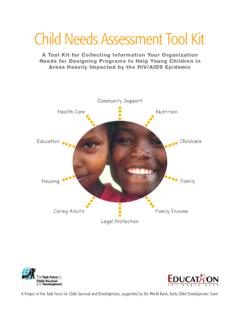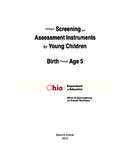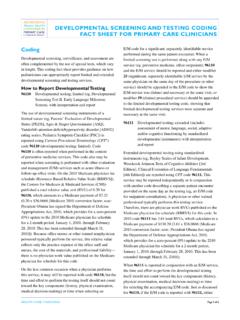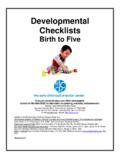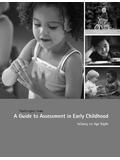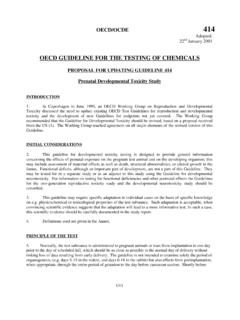Transcription of Battelle Developmental Inventory, Second Edition …
1 Battelle Developmental inventory , Second Edition (BDI-2)Holli Ford, M. Ed., Developmental inventory 2ndEd. The BDI-2 is a comprehensive Developmental assessment tool for infants and young children. Developed by Jean Newborg, 2004 Norm-Referenced / Provides Standard Scores The cost is approximately $1,200 dollars for the initial kit & set of manipulatives. Additional scoring sheets can be ordered. Electronic kits can be ordered for an additional cost. Formats for hand scoring or scoring with computer softwareAssessment Kit 5 Test Item Books One for each domain Each booklet is divided by subdomains Examiner's Manual Stimulus Book Set of Presentation Cards 15 Record Forms (Protocols) and 15 Workbooksfor written tasks Screening Test Item Book with 30 Screening Test Record Forms Set of Screening Presentation Cards, Screening Stimulus Book The BDI-2 ManipulativesKit with all testing materials Two carrying cases -One for the ManipulativesKit and one for the assessment Materials Administration Ages: Birth through 7 years 11 months Testing time.
2 Can range anywhere from one hour to several hours according to the age and Developmental level of the child May be administered as part of an individual assessment by a single examiner, by an assessment team or as part of an arena assessment . *This assessment can be challenging to administer using a single examiner. I would recommend using at least 2 examiners as a minimum. Three examiners will maximize your testing time One person administering, one person supporting the child, one person swapping out materials between questions. Individual disciplines can assess the domains independently as needed for example, if the SLP is only assessing Communication or if the OT/PT only need additional scores for physical development.
3 Administration Each of the 5 Developmental domains can be assessed individually and independently. The 5 domains may be assessed in any order. Starting points are marked by age in each subdomain. Scores can be reported for each individual domain. If all five domains are tested, an additional score for overall general development can also be obtained. Best Practice for early childhood providers is that all five domains are assessed, as delays in one area of development may have impacted development in another area of development. It is always better to assess and determine there is no delay than to assume the child has no delays in a specific domain that was not the primary area of concern.
4 Administration Test administrators will use three different formats to obtain information about each child: Structured activities for direct assessment . Detailed and scripted formats are provided for administration of the structured questions. Observation of activities in a child s natural environment such as the home, daycare, preschool or classroom settings. These should include observation of structured activities, interaction with adults and peers, and play activities. Interviews with parents, caregivers and/or teachers. This process will also give you access to information that you would be unlikely to gain through observation or direct assessment . Ex: Does your child sleep through the night?
5 The Interview Questions are scripted and detailed in addition to providing follow-up questions to assist in scoring I feel it is easier and most efficient to administer all items that can be done in the structured format at one time and then complete the observations of the child in play and social settings. By saving the interview process for last, you are able to finalize the administration process with the questions that need to be completed by interview, including questions that can be done by interview that you were not able to score during the structured and observation sessions. Additionally, children find it difficult to have to wait if you frequently pause during structured activities to ask parents, caregivers or teachers the interview questions.
6 Administration The BDI-2 can be administered to children with various disabilities by using stated modifications. Any modifications used should be documented on the Eligibility Report. It is offered in English and Spanish Versions there are specific cautions noted in the manual for administering the assessment with children or caregivers whose first language is not English. Scoring assessment items are scored using the following criteria: 1) A 2 indicates the child s response meets the specified criteria listed in the test manual at the bottom of the page. This indicates the skill has been mastered or the Developmental milestone has been reached. 2) A 1 indicates the child may have emerging skills or may have attempted the task, without meeting the criteria considered necessary for the skill to be mastered.
7 3) A 0 typically indicates the child did not attempt the task or the response was not adequate to receive partial credit. This could also indicate an incorrect response or that the child has never had the opportunity to exhibit this You will need to find the Basal and Ceiling in order to calculate the Raw Scores. The Raw Scores from each subdomain are transferred to the front of the protocol on the Scoring Sheet. Begin administering the assessment at the designated starting point. If the child receives a 0 or a 1 for any of the first 3 items administered the examiner should then test backward until the child scores a 2 on three items in a row. The BASAL is established when the child receives a score of 2 on three items in a row.
8 All questions below the BASAL (the questions that come BEFORE the three 2 s on the form are each scored as a 2, even if the child would have scored a 0 or a 1 if the items was CEILING: Where a child is no longer able to perform skills with mastery within a certain age range demonstrated by three 0 s in row. This is the stopping point. Occasionally, you will have some items above or past the ceiling (past the three 0 s) that the child would have received a 1 on if the item has been administered. Or the child may have already received a 1 or a 2 on an item past the ceiling if the evaluator has administered the items. These items are STILL counted as 0 s if they are past the ceiling. There can be several basals and ceilings.)
9 Always pick the basal and the ceiling that are closest together when computing the raw score. Chronological Age To obtain accurate results, the examiner must determine the child s age to the month. (45 months) This is necessary for scoring the assessment AND for establishing a starting point for administering the DAYC-2. This can be calculated by hand or by using an online application such as the one noted below. Once you have the years and the months, ignore the remaining days. Do not round up to the next month if the days are over 15 days. Calculating AgeScreening date: 11/17/2013 Child s date of birth: 2/12/2010 Chronological age: 3 years and 9 months (drop the days)Chronological age in months: 45 monthsCalculating AgeScreening date: 11/17/2013 Child s date of birth: 12/20/2010 Chronological age: 2 years and 10 months (drop the days) Chronological age in months: 34 monthsThis example requires borrowing from the month and the year columns: When the day of a child s birth is greater than the screening date day , subtract one month from the date of the screening date month and add 30 days to the screening date day This example would look like: 30 + 17 = 47 then 47 20 = 27 days.
10 The Month now changes from 11 to 10 . When the child s birth date month is greater than the number of the screening date month , subtract one year from the screening date year and add 12 months to the screening date month This example would look like: (Remember that 11 changed to 10 when you borrowed for the days) So, 10 + 12 = 22 then 22 12 = 10 months. The Year now changes from 2013 to 2012. (2012 2010 = 2 years) This is the Scoring Form on the front of the protocol booklet. The raw scores are used to calculate scaled scores for the subdomains, percentiles for the subdomains, and age equivalents for the subdomains. The subdomain scaled scores within each domain are added together to calculate the scaled score for each of the 5 Developmental domains.
